Wazwan
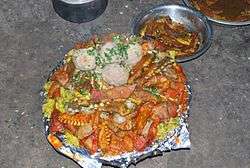
Wazwan is a multi-course meal in Kashmiri cuisine, the preparation of which is considered an art and a point of pride in Kashmiri culture and identity. Almost all the dishes are meat-based using lamb or chicken with few vegetarian dishes. It is popular throughout the Kashmir. Moreover, Wazwan is also served internationally at Kashmiri food festivals and reunions.[1]
History
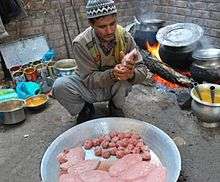
In the Kashmiri language, waz means 'cook' or 'cooking' and wan means 'shop'. The ultimate formal banquet in Kashmir is the royal wazwan. Of its thirty-six courses, between fifteen and thirty can be preparations of meat, cooked overnight under the supervision of a master chef called a vaste waze. Guests are seated in groups of four and share the meal out of a large copper platter called the traem. For Kashmiri Muslims, the meal begins with invoking the name of Allah, for Kashmiri Hindus the name of Lord Shiva and a ritual washing of hands in a basin called the Tash-t-naer, which is taken around by attendants. Then the traem arrive, heaped with rice, quartered by two seekh kababs and contains four pieces of methi korma (chicken or mutton flavored with a spice mixture containing dried fenugreek (methi) leaves), two tabak maaz (twice-cooked lamb ribs, initially braised with ground spices and milk, then browned in butter), one safed kokur (chicken with white sauce), one zafran kokur (chicken with saffron sauce), and the first few courses. Yogurt and chutney are served separately in small earthen pots. Up to about 20 items are served thereafter by waza (the junior cook). Seven dishes are a must for these occasions — tabakh maaz, rista (meatballs in a red, paprika-saffron-fennel spice gravy colored with dyer's alkanet), rogan josh, daniwal korma (lamb roasted with yoghurt, spices and onion puree, topped with coriander leaves), aab gosh (lamb chunks cooked with a fennel-based spice mixture, cardamom and partially evaporated milk), marchhwangan korma (chicken legs/thighs cooked in a spicy browned-onion sauce) and gushtaba (meatballs cooked in a spicy yoghurt gravy).[2][3] The main course usually ends with gushtaba.[4] Gushtaba is like a big meat ball which means full stop.After that deserts are server.In winters it can be a hot sweet dish and in summer it can be an ice-cream.
List of main dishes
- Maithi maaz
- Rista (meatballs in a fiery red gravy)[2][3][4]
- Lahabi kabab or Moachi kabab (flattened mutton kababs cooked in yogurt)
- Waza kokur (two halves or two full chicken cooked whole)
- Daeni phoul (mutton dish)
- Doudha ras (mutton cooked in sweet milk gravy)
- Rogan josh (tender lamb cooked with Kashmiri spices)[2][4]
- Tabak maaz (ribs of lamb simmered in yogurt till tender, then fried)[3]
- Daniwal korma (a mutton curry with coriander)
- Waza palak (green spinach cooked with small mutton balls known as paliki riste)
- Aab gosh (lamb cooked in milk curry)[3]
- Marchwangan korma (an extremely spicy lamb dish)
- Kabab (minced meat roasted on skewers over hot coals)[4]
- Gushtaba (a velvety textured meatball in white yogurt gravy)[2][3][4]
- Yakh'n (delicately spiced yogurt curry)[2]
- Ruwangan chhaman (cheese squares with tomato gravy)
- Dum aelva (potatoes cooked in yogurt gravy)
- Dum aloo[4]
- Gand Aanchaar(Cutted Onions are mixed with Chilli salt Yogurt with some Spices)
- Muji chetin or Mooli akhrot chutney (a sharp radish and walnut chutney)[2]
- Phirni (a milk pudding thickened with semolina or ground rice, flavored with cardamom and optionally saffron, set in individual bowls with silvered nuts and silver leaf)[2][3][4][5]
- Wazwan varieties
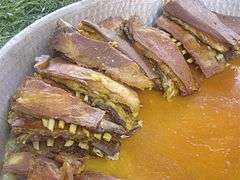 Tabak maaz
Tabak maaz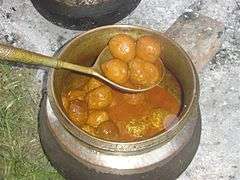 Rista
Rista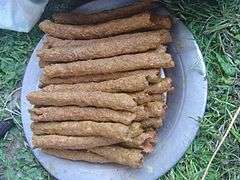 Kabab
Kabab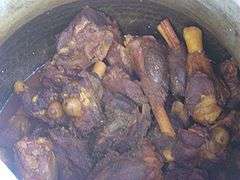 Dani phol
Dani phol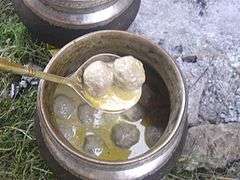 Goshtaba
Goshtaba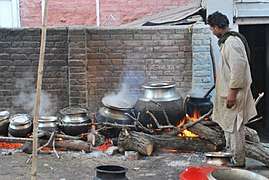 Preparation of wazwan
Preparation of wazwan
See also
References
- ↑ "Wazwan Information".
- 1 2 3 4 5 6 7 "Wazwan Menu". The Manor Delhi. Retrieved 20 October 2016.
- 1 2 3 4 5 6 "Wonders of the Wazwan". The Hindu. 11 April 2012. Retrieved 20 October 2016.
- 1 2 3 4 5 6 7 Gupta, Namita (2 June 2016). "Wazwan from the valley". Deccan Chronicle. Retrieved 20 October 2016.
- ↑ "Dish List".
Further reading
| Wikimedia Commons has media related to Wazwan. |


